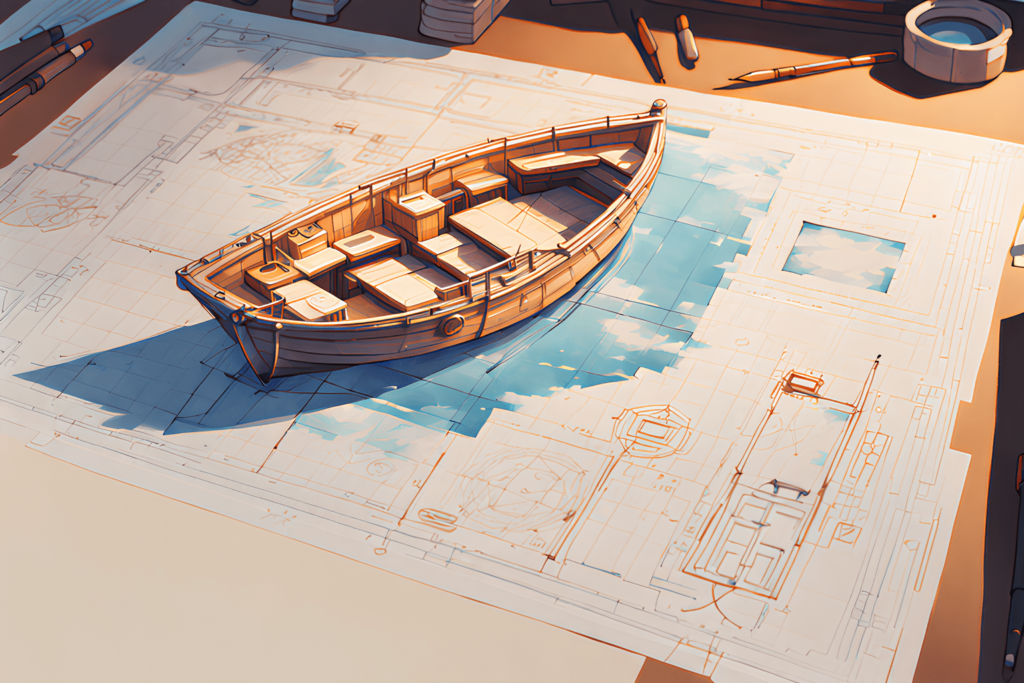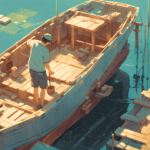Ever dreamed of making your own boat with just materials and willpower? What if building a boat could be a fun weekend project?
DIY small boat plans open a world for those who love to build their own watercraft. There are 719 boat blueprints, covering motorboats, sailboats, and paddle vessels. You can choose from 19 unique designs, from small 8-foot boats to big 16-foot ones.
Building a boat today is more than a hobby—it’s an art that mixes skill, engineering, and creativity. Whether you want a fishing dory, a fun runabout, or a small motorboat, there’s a guide for every skill level and dream.
Key Takeaways
- Explore 19 different DIY boat designs up to 16 feet long
- Select from motorboats, sailboats, and paddle vessel plans
- Discover boat blueprints suitable for various skill levels
- Learn construction techniques like stitch and tape methods
- Choose from designs ranging in weight and performance capabilities

Introduction to DIY Small Boat Plans
Exploring small craft designs is exciting for amateur shipwrights and boating fans. Building your own boat is a mix of creativity, skill, and personal success. It’s more than just buying a boat.
What Are DIY Small Boat Plans?
DIY small boat plans are detailed guides for building your own boat. They include:
- Precise measurements and cutting diagrams
- Material lists for homemade boatbuilding tutorials
- Step-by-step construction techniques
- Recommended tools and equipment
Benefits of Building Your Own Boat
“Creating your own boat is more than a project – it’s an adventure in craftsmanship and personal satisfaction.”
Building your own boat has many benefits. These include:
- Significant cost savings compared to buying a pre-made boat
- Complete customization of design and features
- Deep personal satisfaction from building something with your own hands
- Enhanced understanding of boat mechanics and construction
Overview of Popular Small Boat Types
The world of small craft designs offers many options. You can build lightweight canoes, versatile kayaks, sturdy dinghies, or compact motorboats. Each design has its own challenges and rewards for DIY enthusiasts.
Materials Needed for Boat Construction
Starting a DIY small boat project means picking the right materials and tools. Building a wooden boat needs precision, quality, and special tools. These help turn raw materials into a boat ready for the sea.
Understanding Marine-Grade Materials
Choosing the right materials is key for a successful boat. Marine-grade materials are durable and protect against water damage:
- Marine plywood (1.2 cm thickness recommended)
- Epoxy resins for waterproofing
- Silicone sealants for rigidity and water resistance
- Red and white oak for structural frames
- Specialized marine-grade fir plywood
Tools Required for DIY Boat Building
Boat building guides stress the need for the right tools. You’ll need:
- Circular saw (set to 5 mm depth for precise cutting)
- Japanese crosscut saws
- Drill and drill bits
- Random orbital sanders
- Various clamps
- Chisels and planes
“In tools, you get what you pay for” – Experienced Boat Builders
Costs of Materials and Supplies
The cost of DIY small boat plans depends on the boat’s size and design. Planning your budget helps manage costs while ensuring quality.
| Material | Estimated Cost | Importance |
|---|---|---|
| Marine Plywood | $100-$300 | Critical |
| Epoxy Resin | $50-$150 | Essential |
| Tools | $200-$500 | Necessary |
Pro tip: Pre-drill and countersink all screw holes, and apply silicone for added strength and water resistance in your wooden boat construction project.
Step-by-Step Guide to Building Small Boats
Starting a DIY small boat project needs careful planning and knowing how to build with wood. It’s fun and rewarding, whether you’re new or have experience. You’ll learn a lot from these tutorials.
Planning Your Build: Initial Considerations
Before you start building, think about your skills and the right plans for you. Look at these important points:
- Your current woodworking experience
- Available workspace and tools
- Budget for materials
- Intended use of the boat
Preparing Your Workspace for Boat Construction
Having a good workspace is key for building a boat. Make sure you have:
- Adequate ventilation
- Good lighting
- Stable work surface
- Proper tool organization
Basic Construction Techniques
Knowing basic boat building skills is vital for DIY projects. Here’s a look at common methods:
| Method | Difficulty | Time Required |
|---|---|---|
| Stitch-and-Glue | Beginner | 8-12 hours |
| Strip Planking | Intermediate | 20-40 hours |
| Carvel Planking | Advanced | 40-80 hours |
“Precision is the key to successful boat building. Aim to keep your frames within 1/16″ of accuracy,” advises expert boat builder Mark Thompson.
Remember, patience and attention to detail are your best tools. Measure carefully, prepare well, and stick to your plans.
Popular DIY Small Boat Designs
Exploring DIY small boat plans opens up exciting possibilities for water enthusiasts and boat building guides. Each design offers unique characteristics that cater to different skill levels and intended uses. Whether you’re a beginner or an experienced builder, understanding various small craft designs can help you select the perfect project.

Jon Boats: Simple and Sturdy
Jon boats represent an excellent entry point for DIY boat builders. These flat-bottomed vessels excel in shallow waters and provide remarkable stability. Ideal for fishing and hunting, jon boats typically feature:
- Straightforward construction techniques
- Lightweight materials
- Excellent maneuverability in calm waters
Canoes: Classic and Versatile
Canoes remain a timeless choice in small craft designs. Traditional wooden canoes like the Redwood Canoe showcase craftsmanship and functionality. Modern DIY boat plans for canoes offer:
- Multiple hull configurations
- Adaptability to different water conditions
- Lightweight transportation options
Dinghies: Ideal for Beginners
Dinghies provide perfect opportunities for newcomers to boat building guides. Compact designs like the Holly Point Skiff allow aspiring builders to develop essential skills while creating a functional watercraft. Key advantages include:
- Quick construction time
- Minimal material requirements
- Excellent learning experience
“Every great boat builder starts with a simple design and passion for the craft.”
Selecting the right small boat design depends on your skill level, intended use, and personal preferences. By understanding different boat types, you can embark on an exciting DIY boat building journey.
Understanding Boat Blueprints
Exploring DIY small boat plans means getting to know boat blueprints. These detailed drawings are key for amateur shipwrights. They provide all the necessary information for building a boat.
Boat building guides show that blueprints are more than simple drawings. They are detailed technical documents that outline every important aspect of a boat’s design.
Importance of Accurate Blueprints
Accurate blueprints are essential for successful boat building. They give vital information about:
- Exact hull measurements
- Material specifications
- Construction techniques
- Structural integrity requirements
“A good blueprint is worth its weight in gold for any boat builder.” – Professional Boat Designer
Reading and Interpreting Boat Plans
Understanding boat blueprints means knowing key visual elements:
- Hull-lines drawings showing boat shape from multiple angles
- Sail plans and profiles
- Arrangement plans for interior spaces
- Construction detail drawings
Common Blueprint Symbols and Terminology
Boat building guides suggest getting familiar with blueprint terms. The most common include:
- Sheerline: The sweeping curve of the hull’s top edge
- Offsets: Precise dimensional measurements
- Scale indicators
- Cross-section views
Digital boat plans are usually in PDF format. This makes them easy to access for DIY small boat plan fans. Knowing these technical drawings can make your boat-building journey easier.
Unlock the secrets to building your dream boat with MyBoatPlans! With detailed plans for over 518 boats and expert video tutorials, you’ll have everything you need to create your perfect vessel. Click here to begin your journey!
Choosing the Right Small Boat for Your Needs
Choosing the right small boat needs careful thought. DIY small boat plans let you make a boat that fits your needs perfectly. Before starting, it’s important to know what to look for.
Factors to Consider: Size and Purpose
When picking a boat, consider these key points:
- Where you’ll use the boat (lakes, rivers, coastal waters)
- Your skill level
- How you’ll transport and store it
- Your budget
Comparing Performance: Weight and Speed
How well a boat performs is important. Different boats have different speeds and weights:
Assessing Stability and Maneuverability
Stability is key in DIY boat plans. Wider boats are usually more stable. But narrower boats are faster and easier to steer. Beginners should choose a boat with a stable hull.
Remember: The best boat is one that matches your skill level and intended use.
When looking at boatbuilding tutorials, think about what you need. Talk to experienced builders or join online forums for advice. This will help you pick the right boat for you.
Customizing Your DIY Boat
Building a DIY small boat is a fun way to make a watercraft that shows off your style and needs. Wooden boat construction lets you customize a lot, making your boat special and unique.
- Aesthetic Modifications
- Performance Upgrades
- Technological Integrations
Personalizing Aesthetics and Features
Start with how your boat looks. DIY small boat plans let you choose paint colors, wood finishes, and more. You can pick unique colors or use traditional varnish to highlight the wood.
Upgrading Components for Enhanced Performance
Upgrading your boat can make it better. Here are some things to consider:
| Component | Performance Benefit |
|---|---|
| Advanced Rudder Design | Improved Maneuverability |
| Lightweight Materials | Increased Speed |
| Reinforced Keel | Better Stability |
Incorporating Technology and Accessories
Modern boats can have cool tech to make your time on the water better. Things like GPS, fish finders, and wireless connections can turn a simple boat into a tech-savvy one.
“The beauty of DIY boat building is the freedom to create something truly unique to your needs and vision.” – Maritime Crafting Expert
While making your boat your own is exciting, remember to keep it safe and sturdy. Always check with experts before making big changes to your DIY boat plans.
Safety Considerations in DIY Boat Building
Starting a DIY boat building project is more than just knowing how to build. Safety is key for amateur shipwrights. It keeps the builder safe and the boat in good shape.
Download over 500 Boat Plans. Click on the link below.
-->Click Here<--

Essential Safety Gear for Boat Builders
Keeping yourself safe while building a boat is very important. DIY small boat plans need special safety gear to avoid injuries:
- Safety glasses with side shields
- Heavy-duty work gloves
- Respiratory masks for dust and chemical protection
- Ear protection when using power tools
- Steel-toed boots
Important Tips for a Safe Building Process
Boat building guides say to make a safe workspace:
- Maintain clean and organized work areas
- Use proper ventilation when working with adhesives and paints
- Ensure adequate lighting
- Keep first aid kit readily accessible
Navigating Legal and Regulatory Requirements
Amateur shipwright resources say to know local laws before launching your boat:
| Regulatory Aspect | Requirement |
|---|---|
| Boat Registration | Check state-specific guidelines |
| Safety Equipment | Meet Coast Guard standards |
| Hull Identification | Obtain unique hull number |
“Safety isn’t expensive, it’s priceless” – Unknown Boat Builder
Remember, thorough preparation and respect for safety protocols are your best companions in DIY boat building.
Maintenance Tips for Your DIY Boat
Keeping your DIY boat in good shape is key to its long life and performance. A well-cared-for DIY small boat can serve you for years. This is true whether it’s a wooden boat masterpiece or a simple watercraft.
Routine Maintenance Checklist
To keep your boat in top shape, follow a systematic plan. Here’s a detailed checklist for DIY boat owners:
- Inspect the hull for any signs of damage or wear
- Check all fittings and hardware for corrosion or loosening
- Clean and protect wooden surfaces with appropriate marine varnish
- Examine and lubricate moving parts
- Verify structural integrity of key components
Addressing Common Boat Issues
Every wooden boat project faces challenges. Common problems include:
| Issue | Solution | Frequency of Check |
|---|---|---|
| Minor Hull Leaks | Epoxy repair and waterproof sealant | Quarterly |
| Surface Damage | Sand and refinish affected areas | Bi-annually |
| Hardware Corrosion | Replace or treat with anti-corrosion products | Annually |
Preserving Your Boat for Longevity
Proper storage and protection are vital for your DIY small boat. Key preservation strategies include:
“A well-maintained boat is a sailor’s best companion.” – Traditional Nautical Wisdom
- Store in a covered, dry area away from direct sunlight
- Use protective covers during extended storage
- Apply additional protective coatings annually
- Drain and dry completely after each use
- Implement regular inspection routines
With careful care and attention, your homemade boat can stay seaworthy for many years. It will bring you endless joy and pride in your work.
Resources for DIY Enthuisiasts
Starting a DIY boat building project needs more than just passion and skill. The right tools can make your journey amazing. Good boat building guides and DIY plans are essential for success.
Finding the right resources makes boat construction easier. Whether you’re new or experienced, these tools can improve your skills.
Recommended Books and Guides
- Classic boat building texts from famous designers
- Wooden Boat Design series by top craftsmen
- Comprehensive DIY small boat plans with detailed blueprints
- Technical manuals for advanced construction techniques
Online Communities and Forums
Digital platforms are great for boat building fans. They offer:
- Expert advice from seasoned shipwrights
- Troubleshooting help for tough building issues
- Shared project experiences and photos
- Chances to connect with other DIY boat builders
Workshops and Training Programs
Learning by doing is key for boat building skills. Look into:
- Local maritime training centers
- Weekend boat construction workshops
- Online video courses from boat designers
- Maritime craft programs at community colleges
“The right resources can turn your boat building dream into a seaworthy reality.” – Professional Boat Builder
With over 500 boat plans available for download, you have a lot to choose from. Pick resources that fit your skill level and project goals.
Troubleshooting Common DIY Boat Building Problems
Building your own boat is exciting, but you’ll face challenges. Successful tutorials stress the need to know and fix problems early.
Wooden boat construction needs attention to detail and quick problem-solving. Experienced builders say fixing issues early saves time and money. It also keeps your boat safe and strong.
Addressing Design Flaws and Errors
Design problems can stop your project. Here are some tips:
- Review boat plans carefully
- Compare your work to the blueprint
- Get advice from skilled boat builders
- Use digital tools for precise checks
“Measure twice, cut once” is key in boat building.
Fixing Structural Issues
Structural problems can harm your boat’s safety and performance. Look out for these signs:
- Misaligned hull sections
- Uneven frame construction
- Weak joint connections
- Improper material stress distribution
Dealing with Material Failures
Choosing the right materials and treating them right is vital. Different materials need different care:
- Use marine-grade plywood for water resistance
- Apply the right sealants and coatings
- Check material compatibility before assembly
- Understand how materials expand and contract
Remember, patience and careful inspection are your best tools in preventing and resolving boat-building challenges.
Conclusion: Your Journey in DIY Boat Building
Your DIY small boat project shows your skill and hard work. You picked the right materials, like 6mm marine plywood, and used 748 hot-dipped galvanized screws. This turned raw parts into a boat that shows your talent and love for it.
The guides you followed taught you a lot about building a boat. You learned about making it strong, measuring right, and using special skills. Every challenge you solved is a big step in your journey.
Now, you’re ready for your first trip on the water. The 518 boat plans are just the start. Your focus on details, like using the right tools, has prepared you for a great adventure. Your boat is ready to show off your hard work and skill.
Reflecting on Your Custom Boat Project
Your boat is a big achievement, made with lots of care and creativity. Every detail, like the screws, tells a story of your hard work and love for boat building.
Next Steps: Getting Out on the Water
You’re all set to take your boat out for its first ride. The skills you’ve learned are not just for building. They open doors to new water adventures and learning.
Encouragement for Aspiring Builders
If you’re inspired by your journey, remember that every great boat builder started here. Your eagerness to learn, adapt, and create will guide you in the exciting world of DIY boat building.
FAQ
What are the best materials for building a small boat?
Marine-grade plywood, epoxy resins, and specialized marine hardware are key. Choose weather-resistant materials like marine-grade plywood for durability. Brands like Okoume and marine-grade fir plywood are favorites among DIY builders.
How much does it cost to build a small boat?
Costs vary by design and materials. A basic small boat can cost between $500 and $3,000. Size, design complexity, material quality, and features affect the price. Building it yourself can save a lot compared to buying a pre-made boat.
Do I need special skills to build a small boat?
Basic woodworking and DIY skills help, but many plans are for beginners. Start with simple designs like dinghies or jon boats. Patience and a willingness to learn are more important than technical skills. Online tutorials and resources can guide novice builders.
What tools do I need to build a small boat?
You’ll need a circular saw, drill, sanders, clamps, measuring tape, and safety gear. Special tools like a plane and epoxy application tools might be needed. Many builders already have basic tools, which can save money.
How long does it take to build a small boat?
Time varies from 50 to 300 hours, based on complexity and skill. A simple kayak might take 50-100 hours, while a sailboat could need 200-300 hours. Builders often work on weekends, spreading the project over weeks or months.
Are DIY boat plans legal?
Yes, DIY boat plans are legal if you follow local rules. Make sure your boat is safe, registered, and has the right safety gear. Check with local maritime authorities for specific requirements.
Where can I find reliable boat building plans?
Look for plans on websites like Glen-L, Chesapeake Light Craft, and WoodenBoat Magazine. Online marketplaces, forums, and books also offer plans. Always check the plan source’s reputation and read reviews from other builders.
What are the most beginner-friendly boat designs?
Kayaks, canoes, and simple jon boats are great for beginners. Designs like the Stitch-and-Glue kayak or flat-bottom jon boat are easy to build. They require fewer complex techniques, making them perfect for first-timers.
How do I ensure my DIY boat is safe?
Follow plan instructions, use marine-grade materials, and apply proper sealing. Wear safety gear during construction and follow marine safety rules. Consider having an experienced builder review your work before launching.
Can I customize my boat design?
Yes, DIY boat building lets you customize. You can modify designs to fit your needs, add personal touches, and use modern technologies. Just make sure changes don’t harm the boat’s structure or performance.



